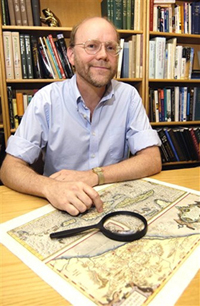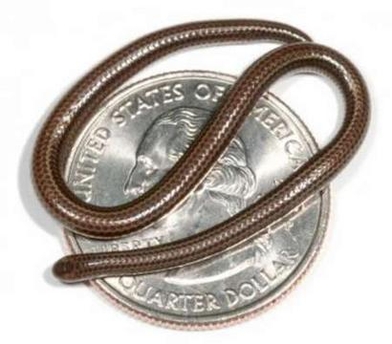
August 10, 2008

The inhabitants of Barbados are mad as hell at Blair Hedges (above) and they want the world to know it. Recently mentioned here was the announcement of the finding of the world’s tiniest snake.
However, long gone are the days of something that is ethnoknown and then calmly being “discovered” by scientists.

Associated Press writer Danica Coto gets to the bottom of the story: A small snake has sparked a big debate in Barbados. Residents of the wealthy Caribbean nation have been heating up blogs and clogging radio airwaves to vent their anger at a U.S. scientist, who earlier this week announced his “discovery” of the world’s smallest snake and named it Leptotyphlops carlae, after his wife Carla.
“If he needs to blow his own trumpet … well, fine,” said 43-year-old Barbadian Charles Atkins. “But my mother, who was a simple housewife, she showed me the snake when I was a child.”
One writer to the Barbados Free Press blog took an even tougher tone, questioning how someone could “discover” a snake long known to locals, who called it the thread snake.
“How dare this man come in here and name a snake after his wife?” said the writer who identified themselves as Margaret Knight.
The man she refers to is Penn State University evolutionary biologist S. Blair Hedges, whose research teams also have discovered the world’s tiniest lizard in the Dominican Republic and the smallest frog in Cuba.
Hedges recently became the first to describe the snake — which is so small it can curl up on a U.S. quarter — when he published his observations and genetic test results in the journal Zootaxa.” Full-grown adults typically are less than 4 inches long.
Hedges told The Associated Press on Friday that he understands Barbadians’ angry reactions, but under established scientific practice, the first person to do a full description of a species is said to have discovered it and gives it a scientific name.
He said most newly “discovered” species are already well known to locals, and the term refers to the work done in a laboratory to establish a genetic profile. In the study, he reported that two specimens he analyzed were found in 1889 and 1963.
“There are no false claims here, believe me,” Hedges said.
Damon Corrie, president of the Caribbean Herpetological Society, acknowledged that Hedges is the first to scientifically examine and describe the snake, but the so-called discovery makes locals seem ignorant.
“It gives the impression that people here … depend on people from abroad to come and show us things in our own backyard,” Corrie said.
Karl Watson, a historian and ornithologist at the University of the West Indies in Barbados, said it’s common for people to get excited over very tiny or very large animals.
“Probably people have overreacted. … It’s nationalism going a bit awry,” Watson said.
Hedges agreed: “I think they’re carrying it a bit too far.”
“Snakes are really apolitical,” he said.
About Loren Coleman
Loren Coleman is one of the world’s leading cryptozoologists, some say “the” leading living cryptozoologist. Certainly, he is acknowledged as the current living American researcher and writer who has most popularized cryptozoology in the late 20th and early 21st centuries.
Starting his fieldwork and investigations in 1960, after traveling and trekking extensively in pursuit of cryptozoological mysteries, Coleman began writing to share his experiences in 1969. An honorary member of Ivan T. Sanderson’s Society for the Investigation of the Unexplained in the 1970s, Coleman has been bestowed with similar honorary memberships of the North Idaho College Cryptozoology Club in 1983, and in subsequent years, that of the British Columbia Scientific Cryptozoology Club, CryptoSafari International, and other international organizations. He was also a Life Member and Benefactor of the International Society of Cryptozoology (now-defunct).
Loren Coleman’s daily blog, as a member of the Cryptomundo Team, served as an ongoing avenue of communication for the ever-growing body of cryptozoo news from 2005 through 2013. He returned as an infrequent contributor beginning Halloween week of 2015.
Coleman is the founder in 2003, and current director of the International Cryptozoology Museum in Portland, Maine.
Filed under Breaking News, Conspiracies, Cryptotourism, CryptoZoo News, Cryptozoologists, Cryptozoology, New Species